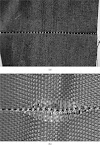Compact Spinning Process
Compact spinning is nothing but re-engineering of existing ring spinning process by attaching a pneumatic zone to existing ring spinning machine. Required improvement in yarn quality and yarn structure with the better use of fibre properties can be achieved with compact spinning process.
The purpose of a compact spinning
process is to spin the strands in the parallel form and completely close before
twisting is delivered. This is the most important aspect of a compact yarn.
This closer and equitable arrangement of the fibres immediately before the
twist is delivered is bound to the advantages of the compact yarn.
Why compact spinning?
·
In
conventional ring spinning, fibres in the selvedge of strand emerging from
front roller nip do not get fully integrated into the yarn because of the
restriction to twist flow by the spinning triangle These fibres show up partly
as protruding hairs or as wild fibres
·
The
spinning triangle exists because of higher width of the strand as compared to
final yarn diameter. Further the fibres are tensioned to varying extent
depending upon their position in the spinning triangle. As a result full realization
of fibre strength is not achieved in the yam.
·
The
hairiness gives a rough feel to the yarn. Variation in hairiness is a source of
weft bars and warp way streaks in the fabric. Long protruding hairs from the
yam contribute to multiple breaks in weaving and fabric faults like stitches
and floats.
·
This
problem is solved by applying the compact spinning systems that increases yarn
quality At is carried out by means of narrowing and decreasing the width of the
band of fibres which come out from the drawing apparatus before it is twisted
into yarn, and by the elimination of the spinning triangle. It can be used for
spinning both short and long staple yarns.
·
The
compact spinning process produces a new yarn structure, which approaches the
ideal staple fibre yarn construction even more closely. This has positive
effects on raw material use, productivity, downstream processing, and on the
product appearance.
Advantages of Compact Spinning –
1.
Higher
yarn strength
2.
Better
elongation
3.
Lower
hairiness
4.
High
consistency of all yarn parameters
5. Minimal variation between spinning positions
6.
Better
yarn evenness
7.
Lower
imperfection value (IPI)
8.
Increase
in production due to reduced yarn twist and higher spindle speed
Some of the compact spinning
machines by Rieter
1.
Compact-Spinning
Machine K 48
The
compact-spinning machine K 48 produces compact yarns with highest performance
and lowest energy consumption. The fully electronic drafting system FLEXIdraft
provides extraordinary flexibility to the machine. The integrated individual
spindle monitoring system ISM premium ensures a high level of machine
efficiency.
2.
Compact-Spinning
Machine K 47
The
compact-spinning machine K 47 produces compact yarns using an extremely low
amount of energy. With the semi-electronic drafting system, the machine meets
all requirements for an economical yarn production. The integrated individual
spindle monitoring system ISM basic can save about 3% of the personnel costs
and makes the K 47 a highly efficient machine.
3.
Piecing
Robot ROBOspin
The piecing
robot ROBOspin repairs ends down in Rieter ring and compact-spinning machines.
Automating this process ensures a high productivity, reduces labor costs and
makes the operational organization of the spinning mill easier.
4. Compacting Device COMPACTdrum
The
compacting device COMPACTdrum for the Rieter ring spinning machine is easy to
install and remove. It adds a new dimension to reducing hairiness, which
impresses customers along with the very low production costs. The device
processes all raw materials and covers all yarn counts.
















1 Comments
tiorapgi-eLafayette Brandi Sampy https://marketplace.visualstudio.com/items?itemName=7magmarnesa.Fenimore-Fillmore--3-Skulls-Of-The-Toltecs-gratuita
ReplyDeleteinavifchar
If you have any doubts, please don't hesitate to ask